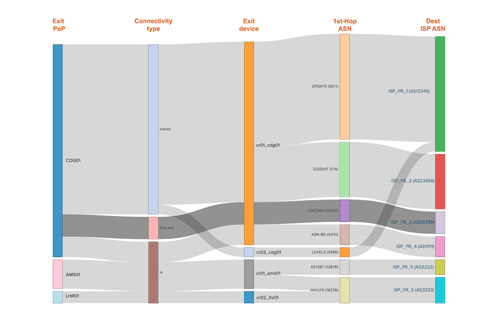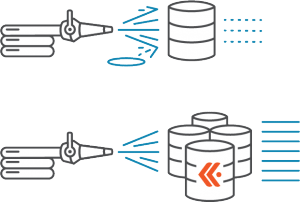From NetFlow Analysis to Business Outcome


Summary
Enabling digital transformation with network data

Over the last few years a lot has been written about the necessity for businesses of all types to embark on a digital transformation. This isn’t just an academic theory as demonstrated in the recently published book entitled Leading Digital. That book discussed how over 400 large companies in traditional industries such as finance, manufacturing and pharmaceuticals are making that transformation.
The US retailer Home Depot is an example of a traditional company that is in the process of transitioning to become a digital business. According to an April 1, 2014 article in CIO magazine, Home Depot has already implemented:
- Onmichannel systems that include BORIS (buy online, return in store), BOSS (buy online, ship to store), and BOPIS (buy online, pick up in store);
- A project to create a mobile mapping application aimed to help customers more easily find items in Home Depot’s cavernous stores.
- Analytics to monitor the online pricing of its rivals and to adjust its own prices in real time.
The impact that the transformation to become a digital business has on IT organizations was discussed in an article in Forbes entitled The Top 10 Strategic CIO Issues for 2014. The Forbes article discussed the changing role of the CIO and stated that “Any CIO pining for a return to the good old days of bonuses based on server-uptime and SLA enforcement should consider swapping out the CIO title for a new one: senior director of infrastructure.” The article went on to say that “the CIO job itself continues to undergo a profound transformation that is pushing business-technology leaders inexorably closer to customer demands and customer experiences and customer engagements; to revenue generation, enhancement, and optimization; and to sometimes-revolutionary new business models and operating models, and unheard-of new processes.”
Similar to what was said in the Forbes article, in the book that I wrote entitled Transforming to a Digital Business I pointed out that two of the key characteristics of a digital business are:
- Agile business models and rapid innovation;
- An agile IT Function.
Each of the characteristics listed above depends on collaboration. For example, a company can’t have agile business models and rapid innovation if it’s difficult for the company’s business units and business leaders to work together to explore new ideas. In similar fashion, it isn’t possible to have an agile IT function without close collaboration by all of the relevant parties.
Where the Network Comes into Play

At the same time that IT functions are working to facilitate the movement to become a digital business they are facing a spectrum of technical challenges. Most of these challenges stem from the fact that we are moving away from the traditional IT environment in which the IT organization owned and deployed a variety of hardware-based devices in facilities that they controlled. In the emerging IT environment, there are hardware and software-based devices, some of which are owned by the business and some of which are owned by the employees. Increasingly these devices are not housed in facilities owned by the business.
There is a critical commonality between the traditional and the emerging IT environment. That commonality is that the network touches everything. As a result, management data gleaned from the network using a technology such as NetFlow can provide multiple levels of value. One level of value is that IT becomes more agile. It can, for example, troubleshoot problems more quickly independent of the source of the problem since traffic is device agnostic. Another level of value is that business leaders gain insight into their business processes and can better understand what’s working and what needs to be changed.
Network Data Analysis Needs Transformation Too
As the value of IT and business agility becomes better understood the focus of technology leaders shifts toward positioning organizations to reap the benefits. Traditional approaches to collecting, storing, accessing, and analyzing management data fall short in that regard because they don’t enable the requisite ease of collaboration.
Part of the challenge with the traditional approach is that only relatively small amounts of management data are stored for more than a brief period of time and the management data tends to be specific to a particular technology domain. Another part of the challenge with the traditional approach is that the typical interface to the management data is through a GUI or through a canned report. A GUI is fine if all you want to do is to drill down into a narrowly defined situation such as why some indicator icon has changed from green to yellow. A GUI is not helpful, however, if you want to get broader insight into what is happening in the network or in a key business process. A canned report is fine if all of the information you want is contained in that report. If it isn’t, you typically have to work with your vendor and wait for months for a new or enhanced report. There is no doubt that in our industry we overuse the word agile. As a result, it is sometimes difficult to know exactly what it means to be agile. That said, taking months to get the management insight you need is a good example of not being agile.
The solution is to move away from the traditional approach to collecting, storing, accessing and analyzing management data and to adopt a big data approach. By being able to capture and store large data sets for a long period of time, network organizations are in position to be able to identify problems and analyze trends across the entire IT infrastructure, whether the infrastructure is traditional or emerging. However, in order to fully leverage those large data sets, network organizations need programmatic interfaces into them so that professionals from every part of the IT organization can access the same data and work collaboratively. In similar fashion, a big data approach combined with programmatic interfaces enables business units to also work collaboratively to identify problems, analyze trends in their business processes and identify where there are opportunities. The ability to do this is important if the business is a traditional bricks and mortar type company and it is critical as the company evolves towards becoming a fully digital business.


